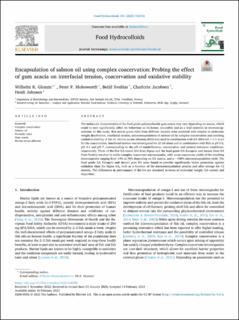| dc.contributor.author | Glomm, Wilhelm | |
| dc.contributor.author | Molesworth, Peter Patrick | |
| dc.contributor.author | Yesiltas, Betül | |
| dc.contributor.author | Jacobsen, Charlotte | |
| dc.contributor.author | Johnsen, Heidi | |
| dc.date.accessioned | 2024-04-10T11:07:26Z | |
| dc.date.available | 2024-04-10T11:07:26Z | |
| dc.date.created | 2023-06-14T12:49:28Z | |
| dc.date.issued | 2023 | |
| dc.identifier.citation | Food Hydrocolloids. 2023, 140: 108598. | en_US |
| dc.identifier.issn | 0268-005X | |
| dc.identifier.uri | https://hdl.handle.net/11250/3125783 | |
| dc.description.abstract | The molecular characteristics of the food-grade polysaccharide gum acacia may vary depending on source, which could in turn significantly affect its behaviour as thickener, emulsifier and as a wall material in microencapsulation. In this study, five acacia gums (GA) from different sources were screened with respect to molecular weight distribution, interfacial tension, microencapsulation of salmon oil by complex coacervation and resulting oxidative stability of the oil. Bovine serum albumin (BSA) was used in combination with GA (BSA:GA = 1:1 w:w) for the coacervation. Interfacial tension was investigated for all GA alone and in combination with BSA at pH 5.5, pH 4.2 and pH 7, corresponding to the pH of emulsification, coacervation and neutral/reference conditions, respectively. Three of the five GA tested (GA from Sigma and the food grade GA Encapcia and Instant Gum BA from Nexira) resulted in stable complex coacervate microcapsules, with mean coacervate yields of the resulting microcapsules ranging from 34% to 76% depending on GA source, and a ∼100% microencapsulation yield. The food grade GA Encapcia and Instant gum BA were found to provide significantly better protection against oxidation than the Sigma GA, both as a function of the microencapsulation process and after storage for 12 months. The differences in performance of the GA are discussed in terms of molecular weight, GA variety and impurities. | en_US |
| dc.language.iso | eng | en_US |
| dc.rights | Navngivelse 4.0 Internasjonal | * |
| dc.rights.uri | http://creativecommons.org/licenses/by/4.0/deed.no | * |
| dc.title | Encapsulation of salmon oil using complex coacervation: Probing the effect of gum acacia on interfacial tension, coacervation and oxidative stability | en_US |
| dc.title.alternative | Encapsulation of salmon oil using complex coacervation: Probing the effect of gum acacia on interfacial tension, coacervation and oxidative stability | en_US |
| dc.type | Peer reviewed | en_US |
| dc.type | Journal article | en_US |
| dc.description.version | publishedVersion | en_US |
| dc.rights.holder | © 2023 The Authors. Published by Elsevier. | en_US |
| dc.source.pagenumber | 8 | en_US |
| dc.source.volume | 140 | en_US |
| dc.source.journal | Food Hydrocolloids | en_US |
| dc.identifier.doi | 10.1016/j.foodhyd.2023.108598 | |
| dc.identifier.cristin | 2154439 | |
| dc.relation.project | Norges forskningsråd: 303497 | en_US |
| dc.source.articlenumber | 108598 | en_US |
| cristin.ispublished | true | |
| cristin.fulltext | original | |
| cristin.qualitycode | 1 | |

